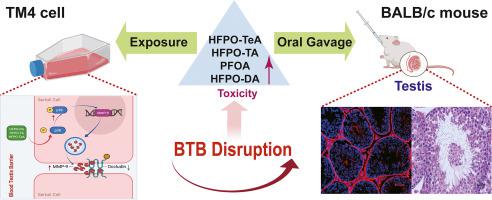Science of the Total Environment ( IF 8.2 ) Pub Date : 2022-07-14 , DOI: 10.1016/j.scitotenv.2022.157313 Bi-Xia Peng 1 , Fangfang Li 2 , Monika Mortimer 2 , Xiang Xiao 3 , Ya Ni 3 , Yuyang Lei 1 , Minjie Li 4 , Liang-Hong Guo 2

|
As alternatives to perfluorooctanoic acid (PFOA), hexafluoropropylene oxide (HFPO) homologues, including hexafluoropropylene oxide dimer acid (HFPO-DA), hexafluoropropylene oxide trimer acid (HFPO-TA), and hexafluoropropylene oxide tetramer acid (HFPO-TeA), have attracted widespread attention recently due to their environmental ubiquity and high potential for bioaccumulation and toxicity. In the present study, a set of in vivo mouse and in vitro mouse testicular Sertoli TM4 cell experiments were employed to explore the male reproductive toxicity and underlying mechanisms of HFPO homologues on blood-testis barrier. Tissue and permeability analyses of mice testes after 28-day treatment with 5 mg/kg/day HFPO-DA or PFOA, or 0.05 mg/kg/day HFPO-TA or HFPO-TeA indicated that there was an increase in the degradation of TJ protein occludin in mice with a disrupted blood-testis barrier (BTB). Following exposure to 100 μM HFPO-DA, HFPO-TA or 10 μM PFOA, HFPO-TeA, transepithelial electrical resistance measurements of TM4 cells also indicated BTB disruption. Additionally, as a result of the exposure, matrix metalloproteinase-9 expression was enhanced through activation of p38 MAPK, which promoted the degradation of occludin. On the whole, the results indicated HFPO homologues and PFOA induced BTB disruption through upregulation of p-p38/p38 MAPK/MMP-9 pathway, which promoted the degradation of TJ protein occludin and caused the disruption of TJ.
中文翻译:

全氟辛酸替代物六氟环氧丙烷通过破坏血睾丸屏障发挥雄性生殖毒性
作为全氟辛酸 (PFOA) 的替代品,六氟环氧丙烷 (HFPO) 同系物,包括六氟环氧丙烷二聚酸 (HFPO-DA)、六氟环氧丙烷三聚酸 (HFPO-TA) 和六氟环氧丙烷四聚酸 (HFPO-TeA),已吸引由于它们在环境中无处不在并且具有很高的生物蓄积性和毒性潜力,最近引起了广泛关注。在本研究中,一组体内小鼠和体外采用小鼠睾丸支持TM4细胞实验研究了HFPO同源物对血睾丸屏障的雄性生殖毒性和潜在机制。用 5 mg/kg/day HFPO-DA 或 PFOA 或 0.05 mg/kg/day HFPO-TA 或 HFPO-TeA 处理 28 天后小鼠睾丸的组织和通透性分析表明 TJ 的降解增加血睾丸屏障 (BTB) 破坏的小鼠中的蛋白 occludin。在暴露于 100 μM HFPO-DA、HFPO-TA 或 10 μM PFOA、HFPO-TeA 后,TM4 细胞的跨上皮电阻测量也表明 BTB 破坏。此外,由于暴露,基质金属蛋白酶9的表达通过激活p38 MAPK而增强,从而促进了occludin的降解。总体上,































 京公网安备 11010802027423号
京公网安备 11010802027423号